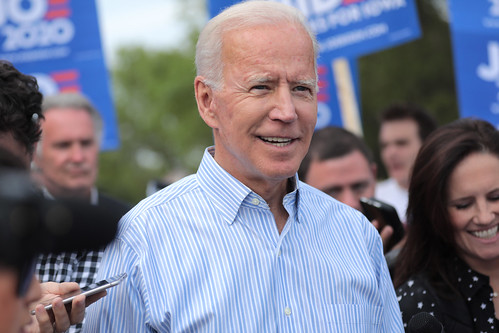The Migrant Surge and the ‘Shelter’ Inflation of 2024
I recently discussed what proponents are lauding as the economic benefits of an unprecedented surge in both legal and illegal alien workers into the United States under the Biden administration, and identified serious downsides decision-makers weren’t considering — including the effects migration is imposing on resources for “housing, education, health care, and sustenance”. Thereafter, the latest inflation numbers came out, showing an unexpectedly high 3.5 percent increase in costs, year over year, in March. Half of that rise was driven by increases in the costs of gasoline and, critically, “shelter”. Economic pundits should realize cheap labor ain’t always cheap and take a look to see whether there’s a connection.
Immigrant Workers and the Growth in GDP. The U.S. Bureau of Economic Analysis defines U.S. GDP as “a comprehensive measure of U.S. economic activity”, which “measures the value of the final goods and services produced in the United States”.
According to a recent analysis by Ernie Tedeschi, erstwhile chief economist for the White House Council of Economic Advisers:
US [Gross Domestic Product, “GDP”] has grown by 8.2% since just before the pandemic, almost twice as fast as the next-best performer in the G7. The rise in the immigrant population since the end of 2019 accounts for at least a fifth (1.6 percentage points) of that US growth, accounting for direct labor supply, unemployment rate, and productivity effects. Absent immigration, the US labor supply would have shrunk by 1.2 million since 2019. Instead, it expanded by 2 million.
My colleague Steven Camarota made similar points about recent changes in the composition of the U.S. labor market, albeit from a slightly different perspective:
We keep hearing that the US economy is strong, especially the job market.
At first glance, this perspective seems to be spot-on. Compared to the fourth quarter of 2019, right before COVID-19 hit, the fourth quarter of 2023 shows 2.7 million more people working.
Except all those gains are among immigrants.
The number of immigrants working over this period is up by 2.9 million, while 183,000 fewer U.S.-born Americans are working.
Put simply, compared to 2019, all the net job growth has gone to immigrants.
As Camarota explained elsewhere, that decline in Americans holding jobs is not because the number of U.S.-born workers has fallen, but rather because the “labor force participation rate” for U.S.-born men aged 18 to 64 without a bachelor’s degree fell from 76.3 percent in Q4 2019 to 75.6 percent in Q4 2023.
That has followed a pattern of decline in the labor force participation rate among that cohort from the 1960s — when more than 90 percent were working — through 2000 (82.6 percent) and 2006 (80.5 percent).
In addition, Camarota notes: “At 66.4 percent, the labor force participation rate of U.S.-born women (18 to 64) without a bachelor’s in the fourth quarter of 2023 has returned to the 2019 level but is still well below the 70.7 percent in 2000.”
The Increase in Inadmissible Aliens. I’ll leave aside the societal costs of the decline in the labor participation rate by U.S.-born workers — isolation, drug use, dependency, etc. — to focus instead on the impacts recent immigrants have imposed on the U.S. economy. To do that, I have to quantify how many “newcomers” have arrived.
In a resolution passed on a bipartisan basis in January, the U.S. House of Representatives found that “the Biden administration has released at least 3.3 million … illegal aliens into the interior of the United States”. Since then, Border Patrol agents at the Southwest border have released more than 225,000 additional illegal migrants, and about 120,000 other aliens have entered through various administration parole schemes.
That brings the new illegal population to somewhere around 3.65 million, a figure does not include 1.8 million “got-aways”, aliens who evaded apprehension at the Southwest border and who successfully entered the United States. Add them in, and you are up to 5.4 million new aliens on the low end — over and above the limits that Congress has already set — since January 2021.
“Consumer Price Index — March 2024”. Not all of them are of working age, but they all need the basics: food, clothing, and a place to live. Which brings me to an April 10 news release from the Bureau of Labor Statistics (BLS) captioned “Consumer Price Index — March 2024”.
It revealed that the Consumer Price Index (CPI) — the key gauge of U.S. inflation — had increased .4 percent last month, for a 12-month increase of 3.5 percent, faster than had been expected and higher than in February.
The news had several implications, not least of which was that rising inflation made it unlikely that the Federal Reserve would cut its key interest rate anytime soon, and possibly not until March 2025. That, in turn, sent stock markets into a tailspin.
What accounted for the unexpected rise in the CPI? As BLS explained: “The index for shelter rose in March, as did the index for gasoline. Combined, these two indexes contributed over half of the monthly increase in the index for all items.” In fact, shelter costs rose 5.7 percent in March compared to a year ago, according to a Forbes analysis.
I have reviewed several assessments of the increase in shelter costs, and none mentions anything about the effects that millions of new arrivals — who came here again, both legally and illegally — have had on the housing market.
That’s a little odd, given the number of glowing assessments lauding the positive effects those aliens’ labor are having on the overall inflation numbers, including from Federal Reserve Chairman Jerome Powell.
Inflationary Impact? There are two reasons, however, why the inflationary impact those aliens are having on the housing market merits serious attention.
The first is that according to the Census Bureau, on January 20, 2021 — the day President Biden took office — the U.S. population stood at 331,755,386. As I write this, the Census Bureau estimates that the population stands at more than 336,315,000 — a calculation that assumes there is “one birth every nine seconds”, “one death every 10 seconds”, and “one international migrant (net) every 27 seconds”.
In other words, according to the Census Bureau, the U.S. population has increased by about 4.5 million since Inauguration Day — both through births and migration.
In reality, given the massive number of got-aways and DHS’s lack of transparency, no one really knows exactly how long it takes for an additional “international migrant” to arrive under the president’s current policies, but given the migrant figures above, the Census Bureau’s estimate is likely low.
In any event, however, and taking the Census Bureau’s January 2021 estimate as correct, inadmissible aliens, here in whole or in part due to the administration’s immigration and border policies, have increased the U.S. population by almost exactly 1.6 percent.
Their arrival was virtually unforeseeable, and given acquisition, finance, permitting, and construction delays, there’s no way that the housing industry could have been expected to accommodate them in the interim.
That’s especially true given that the country is experiencing what NPR describes as a “housing crisis”. The outlet explains:
The U.S. is short millions of housing units. Half of renters are paying more than a third of their salary in housing costs, and for those looking to buy, scant few homes on the market are affordable for a typical household.
And there’s this, from the Government Accountability Office (GAO) in October: “Many low-income renters … face shortages in affordable housing. During the last three years, rents increased about 24%.” Note the part about “the last three years”.
That’s from a GAO report discussing the role the Department of Housing and Urban Development (HUD) plays in encouraging affordable housing starts, including through HUD’s “Housing Trust Fund”. The Fund is “designed to preserve and increase the number of affordable rental units available to extremely low-income households” by providing “funding to states for affordable housing rental projects”. As of March 2022, according to GAO “the Fund’s grantees had developed almost 2,200 rental units in 263 projects”.
Frankly, 2,200 rental units doesn’t seem like a lot when millions of migrants are pouring into the country, but that might just be my opinion.
The second is the very real impact shelter costs and the unavailability of housing are imposing on the northern U.S. cities to which many of them have headed.
Last month, New York City Mayor Eric Adams (D) noted that his city has provided “shelter and care to approximately 183,000 new arrivals since the spring of 2022” in announcing that some of them would be forced to leave municipally provided housing after 30 days.
More than 38,000 migrants have come to Chicago according to the latest city data, and 10,000-plus of them were living in city shelters as of the middle of March. That’s when the Windy City announced its own 60-day shelter limit on occupants.
Massachusetts capped the number of migrant families in its shelters at 7,500 last year, and officials there announced in late March that they would “start implementing a one-month limit on families staying in safety-net shelters on May 1, with new requirements in order to extend their time”.
If fairly well-off states and localities are struggling to find space for migrants, isn’t it reasonable to assume that those and other migrants are placing strains on the availability of commercial housing, as well?
Then, there’s Denver, which has received almost 41,000 migrants. That city is implementing a new program under which it will “place asylum seekers in apartments for up to six months”, with a 1,000 cap.
Respectfully, unless Denver also expands its stock of available apartments significantly, that plan will simply increase the costs other apartment-seekers must pay for housing — unless the laws of supply and demand don’t apply in the Rockies.
It’s reasonable for economic officials to consider the benefits millions of new migrants have had on the U.S. economy. That said, it’s equally important for them to assess the costs those migrants are imposing on the economy, too — and especially on an American housing market that’s in “crisis”, and a key driver of inflation. Cheap labor ain’t always cheap.





